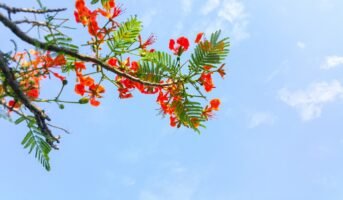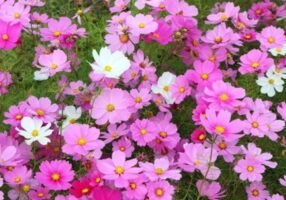Having a big home garden allows you to have various types of larger shrubs and plants. Planting larger varieties of beautiful plants can enhance the beauty of a garden significantly. However, instead of going beyond your gardening skill level and planting exotic fauna that you may not be able to take care of properly, you can choose to take care of beautiful plants that require little to no maintenance.
An easy-to-plant and maintain flowering shrub that can elevate the natural beauty of our garden remarkably is Hydrangea macrophylla.
Key facts to know about Hydrangea macrophylla
Botanical Name of the plant: Hydrangea macrophylla
The common name of the plant: Hydrangea
Family of the plant: Hydrangeaceae
Type of Plant: Hydrangea macrophylla is a shrub or deciduous type of plant.
Colour of the flower: Hydrangea Macrophylla has flowers that bloom in Blue or Pink colours.
Colour of the foliage: Hydrangea macrophylla foliage is of green colour.
Identifiable features of the plant: Flowers are the most identifiable feature of Hydrangea macrophylla.
Average Plant size: 2m in height and a 2.5m spread are the average plant sizes of Hydrangea macrophylla
Required Sun exposure: Hydrangea macrophylla requires dappled shade or Full Sun
The hardiness of stem: Hydrangea macrophylla has a hardy stem
Required Soil type: Hydrangea macrophylla can grow in acidic, chalky, alkaline or clay-heavy soil.
Known about: Swietenia macrophylla
Different types of Hydrangea macrophylla
There are many varieties of Hydrangea macrophylla that you can choose from. For instance, Bigleaf Hydrangeas, also often known as French Hydrangeas, Florist’s Hydrangeas and Hortensia, are the most common variety of Hydrangeas. They can be found in types such as Mophead, Lacecap and Mountain Hydrangeas.
One can easily differentiate between the different varieties of Hydrangea macrophylla by the features of the plants like the foliage, flowers and the shape of the leaves.
What Hydrangeas grow in shade?
Smooth Hydrangea: This type of hydrangea has large, white flowerheads and blooms in summer.
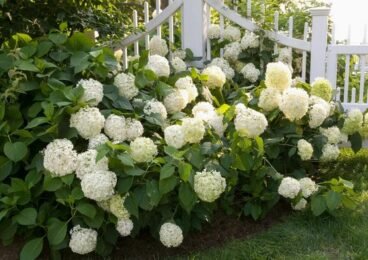
Source: Pinterest
- Climbing Hydrangea: A climbing vine, this hydrangea variety has white flower clusters blooming in the summer. This grows well in partial shade.

Source: Pinterest
- Bigleaf Hydrangea: These grow well in partial shade and blooms large, round flowerheads that are available in blue, pink and white.
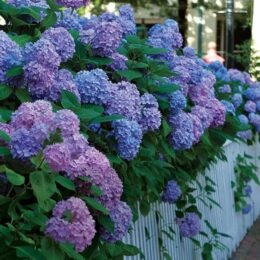
Source: Pinterest
- Oakleaf Hydrangea: Having oak-shaped leaves, this variety of hydrangea also grows well in shade- both partial and full . The flowers of this hydrangea are cone-shaped in white that overtime turns to pink and then brown.
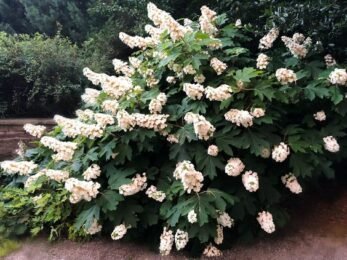
Source: Pinterest
Why do Hydrangea leaves turn brown?
Lack of water and impact of sun results in most leaves turning brown. While Hydrangeas droop at noon, they get back to being their original self once shade sets in. However, more frequently if this happens, plant will sport brown leaves.
Easily identifiable features of Hydrangea macrophylla
The most identifiable part of the Hydrangea macrophylla is its flowers that grow in small bunches during their blooming period. The Hydrangea macrophylla flowers have outer flowers consisting of four sepals. These sepals are large and brightly coloured.
Another identifiable feature of the Hydrangea macrophylla plant is its leaves. The leaves are opposite deciduous, composed of short and fleshy-appearing petiole and a simply-constructed leaf blade.

Source: Pinterest
Can Hydrangea macrophylla be toxic?
Yes, Hydrangea macrophylla plants can be toxic if ingested by humans or pets, although it does not release any poisonous toxins in the air. Symptoms of poisoning from Hydrangea macrophylla are nausea, vomiting, diarrhoea, seizures or even coma. Therefore, it is essential to be careful about the possible ingestion of the plant by any pets or small children.
Planting tips for Hydrangea macrophylla
Hydrangea macrophylla can be planted easily and thrive best in well-draining and fertile soil. Adding a little bit of sand to the soil can help with draining the soil properly. Also, it is crucial to maintain the spacing between the plants to allow Hydrangea macrophylla to grow properly. During the watering of the plant, it is essential to note if the soil is being drained properly because these plants do not grow in waterlogged soil.
You will have to plant the bush by digging a hole in the ground that is 2 feet wider than the root ball of the plant. This will help in creating sufficient space for the roots to take hold in the soil. Also, you should put back the soil in a mould that is helpful to drain the water in the soil.
How to maintain Hydrangea macrophylla as a beginner
There are several tips you must follow to keep up the maintenance of the Hydrangea macrophylla plant. For instance, Hydrangea macrophylla plants require frequent pruning. This is to ensure the proper growth of the plant. For Hydrangea macrophylla, the best times to fertilise are in March, May, and June.
To propagate a hydrangea plant, you can dig a small trench next to it and press down a branch into the soil with the help of a brick, stone or paver on top of it. Eventually, the branch will grow roots of its own and can be propagated to a new spot.

Source: Pinterest
When do Hydrangeas bloom?
Hydrangeas bloom during summers and they continue till around fall time. Hydrangeas bloom are long shrubs. An interesting fact about these beauties is that they have the ability to change the colour of their flowers based on the soil’s pH level.
Why is Hydrangea not flowering?
Hydrangeas may not flower because of pruning that would have gone wrong or damage to the bud because of the winter season. Also, things like location and use of fertilizer impact flowering.
Benefits of having a Hydrangea macrophylla plant in your Home Garden
More than just the aesthetics, the Hydrangea macrophylla plants are also popular in the plant-science community for their medicinal benefits. Hydrangea macrophylla is used for its alkaloids and minerals to cure problems such as inflammation and kidney stones. Moreover, the plant has diuretic properties that help with urine flow for those with urinary tract difficulties and antioxidant properties when used in moderation.
FAQs
Where does the Hydrangea macrophylla plant originate from?
The Hydrangea macrophylla plant’s origins are found in Japan.
What is the best time to plant Hydrangea macrophylla?
The best time to plant Hydrangea macrophylla in your home garden is during spring or fall. However, one must be careful of harsh cold weather during the early growth stages of the plant.
Housing News Desk is the news desk of leading online real estate portal, Housing.com. Housing News Desk focuses on a variety of topics such as real estate laws, taxes, current news, property trends, home loans, rentals, décor, green homes, home improvement, etc. The main objective of the news desk, is to cover the real estate sector from the perspective of providing information that is useful to the end-user.
Facebook: https://www.facebook.com/housing.com/
Twitter: https://twitter.com/Housing
Email: [email protected]



